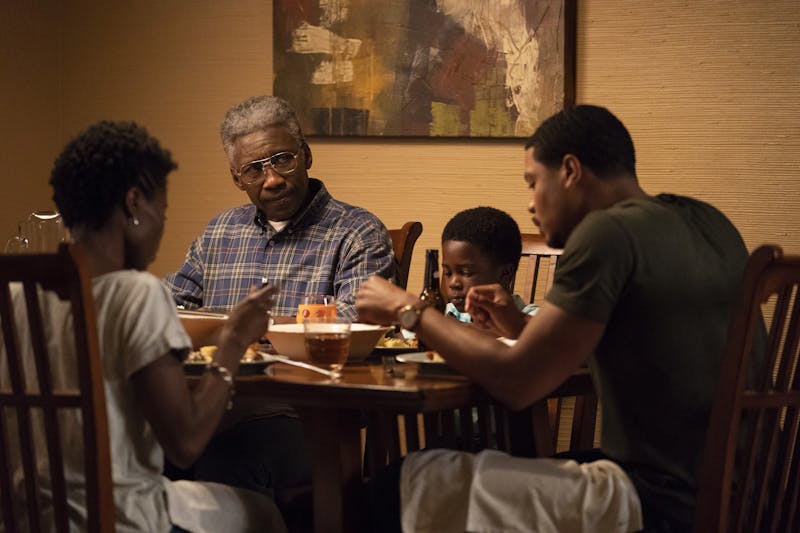The third season of HBO’s True Detective is a return to the first season’s template. This is a response to the errant season two, a much-derided foray into urban policing, corruption, and masculinity. Season two was not, by any stretch of the imagination, a terrible piece of television. But the show’s debut season was simply so good that its sequel was doomed to struggle. In that first eight-part series we watched the classic cop two-hander transform into Bayou-sodden philosophy. The “straight man” was Woody Harrelson as Marty Hart, a philandering father who is undone by his lack of self-awareness. The “maverick” was Matthew McConaughey as Rust Cohle, a man with forearms hewn from oak, a tragic past, and a mind made out of razor blades.
The central conceit of season one was its double-layered narrative. Along one timeline, in 1995, Rust and Marty hunt a rather baroque serial killer. Along the other timeline, over in 2012, two younger cops question our heroes about how Timeline One went down. They suspect that Rust, who by now has taken to mustache-growing and expressing himself in gnomic expressions (“Time is a flat circle”) might himself be the killer. They never got the guy after all—was he under their noses all along?
The two timelines merge into a denouement complete with acid flashbacks, revelations about the meaning of life, and multiple stab-wounds. It was a highly conceptual show, mostly in its focus on philosophical pessimism, but Rust’s sexiness and his love of cocaine and pull-ups (at the same time) kept it entertaining. The final effect was of a gratifying meditation on time and relationships, where narrative form reflected the philosophy espoused by its characters.
True Detective has returned to its original shape in season three. In fact, the repetition is so heavy that it’s a little off-putting. Once again, two younger cops question a pair of aged detectives about a cold case. Once again, we’re in the South—Arkansas’s Ozarks, this time. Once again, we have a complex hottie (Mahershala Ali as Wayne Hays) doing the maverick genius thing, paired with a by-the-book redneck played by aging Hollywood royalty (Stephen Dorff as Roland West). Once again, the partners fall out dramatically, only to reunite in retirement. Once again, there are creepy dolls at the murder scene. And once again, multiple timelines play out through testimony, memory, and tape.

This time, however, there are three stories. Leaving its delicious production aside, True Detective should be credited with giving us the best aging makeup television has ever seen. This new season spans something like five decades, and never looks wrong.
Timeline A shows Wayne and Roland on the case of a missing pair of children in 1980. Timeline B sees the case re-opened ten years later; Wayne’s hair is shorter and by now he is married, to the lovely schoolteacher named Amelia whom he met in Timeline A. Timeline C is the cruelest: Now in retirement, Wayne is struggling to remember his life through the cloud of dementia. A television crew in the model of the podcast Serial has dug up new evidence on the case, and put him in front of a camera. Slowly and reluctantly, Wayne confronts memories of his marriage (Carmen Ejogo plays Amelia with enigmatic appeal) and of the unsolved case. Between hallucinating his wife and waking up in his bathrobe in the middle of the street, Wayne drags Roland out of retirement for one more crack at the mystery. “C’mon,” Wayne says to Roland through old-man tears. “Stir some shit up with me.”
So, yes—this is almost exactly the same TV show that you watched in 2014. But certain changes mark it out. This season features a love story, which adds a little schmaltz and heartache to the proceedings. It’s also much more serious about historical detail. Wayne Hays has the nickname “Purple Haze” from Vietnam, where he learned to track the enemy and suppress his emotions—skills he reprises while on the job. He’s also, obviously, black, working as a cop in the Deep South. While race was a small plot point in season one—the cops who interview the older detectives are both black and Marty calls them “young studs” at one point, to raised eyebrows—it is here at the forefront. N-words abound, and color is integral to the relationship between the two main cops.
The other great difference is Mahershala Ali himself. As the maverick, Matthew McConaughey was great. But Ali manages to outdo him, if only because season three demands so much more. He appears in the majority of scenes in the show, inhabiting three different stages in a single man’s life. The show is eight episodes long, so in terms of screen time it’s as if he has played three different roles in a trio of movies, back to back. The achievement is extraordinary, particularly because he does such a fine job of distinguishing the 30-something man from the 40-something man from the elderly man. The first is restrained but headstrong; the second hamstrung by emotional repression; the last abandoned, almost, to the flood of feeling that he has kept back for so long. His creased regret as an elderly man is impossible not to believe.
In the first five episodes, at least, there is not much new to True Detective round three in terms of the basic set-up. But in its narrative ambition and the great strength of its star, this show has managed to surpass its original outing. Love and time are the great motifs of True Detective and have been since its beginning. At the end of this triple-layered show, we ought to witness those themes configured in unprecedented dimensions. If nothing else, it should garner Ali better roles, more exposure, and bigger checks: No mystery there.
